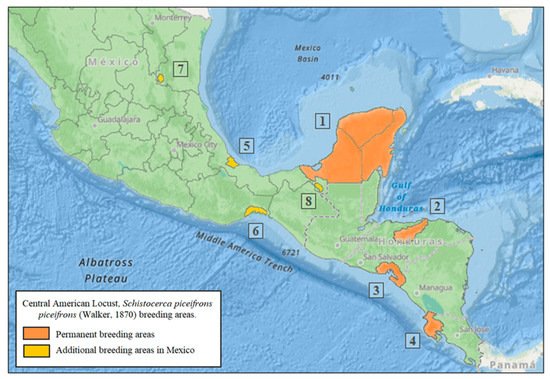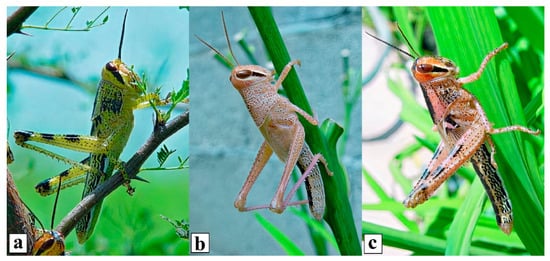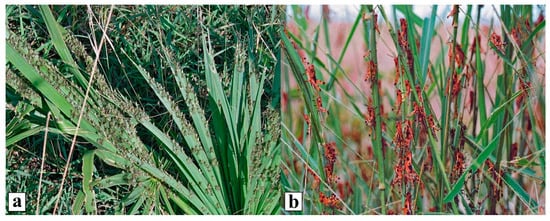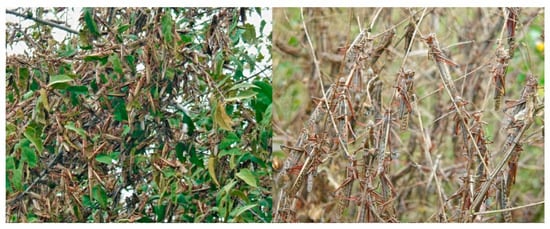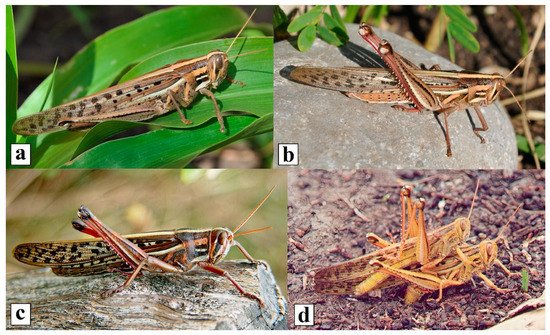Considerable progress has been made on the management of the CAL during recession and outbreak periods [
9,
16,
17,
18,
19,
36,
51,
52,
53,
54,
55,
56,
57,
58,
59,
60,
61,
62]. Management techniques have evolved from the manual and mechanical collection of egg pods, hopper bands, and adult swarms [
1,
2,
3,
4,
14] to the use of prediction models that aim to understand how population dynamics of the CAL relate to environmental factors and local conditions. For instance, a study [
36] on the relationship between sea surface temperatures, the El Niño Southern Oscillation (ENSO), and the potential of the CAL plagues found a 72% coincidence between years of massive CAL attacks and ENSO years in the North Pacific of Costa Rica; an increase of environmental temperature and irregular distribution of precipitation, as occurs during the ENSO years, may result in vigorous copulation and oviposition in the CAL. A population increase is the first step for phase change and eventual plagues. A subsequent work assessed the risk of next-generation nymph-populations, considering an initial adult population and each instar mortality rate [
51]. In another study, a Thermal Time Locust Development Clock (TTLDC) was built considering average values of temperature, day length, diapause cool hours, and calendar dates; this model helped to predict the CAL timing of phenological stages. This model implies a starting date (Bio-fix) established experimentally after quality data on population dynamics and the life cycle of the CAL. When the model was compared with field observations, the differences were relatively small. The reliability of predictions depends upon the accuracy of the starting date and deviations in weather conditions from the average year [
17]. More recently, an early warning system (EWS) for monitoring and management of the CAL habitat in permanent breeding areas in the Huasteca region (Mexican Coastal Plain) and the Yucatán Peninsula was implemented by SENASICA-UASLP (Servicio Nacional de Sanidad, Inocuidad y Calidad Agroalimentaria-Dirección General de Sanidad Vegetal-Universidad Autónoma de San Luis Potosí). This EWS applies multi-criteria models and NOAA-AVHRR satellite images [
15,
19,
32]. The model is based on two variables of the meteorological mesoscale: the presence of the ENSO and drought monitoring; it also takes the CAL behavior into account. Accordingly, the process of band or swarm formation begins when solitarious populations face environmentally unfavorable conditions (grass or crop remnant burning, convergent winds, droughts, or food shortage) and converge in places where vegetation is available. The increase in population density of individuals per unit area leads the insect to gregarize and prepare to migrate in search of food and oviposition sites. Hence, climatic effects are among the fundamental cause of behavioral change, and the host distribution pattern reflects spatially the areas of gregarization and oviposition (greater stress), and the areas of migration in search of food (higher biomass production in agricultural areas). Currently, this EWS proposes that not only the ENSO, but also the La Niña, affects locust breeding and gregarization. Furthermore, there is evidence that as a consequence of the increase of greenhouse gas emissions such as CH
4 and CO
2 in gregarious areas, in the last four years (2017–2020), the drought monitor showed an increase of more than 3 °C in soil temperature in areas proximate to the Gulf of Mexico. These greenhouse gas emissions (CH
4 and CO
2) are produced by anthropogenic livestock activity, which creates more favorable environmental conditions for the reproduction of the CAL [
32]. An additional dynamic simulation model [
18] showed that the growth and development of the CAL in the Yucatán Peninsula was associated with daily rainfall, temperature, and physical soil properties, such as texture and depth. In regard to the growth of non-cultivated grass in breeding zones and oviposition rates, the model estimated both variables as a function of soil moisture. The latest work [
23] focused on a deeper analysis of the environmental factors that affect population dynamics of the CAL and it was found that plant species richness (PSR) and relative species density (RSD) in the Yucatán Peninsula were higher during the rainy season than in the dry season, with RSD the most important variable associated with locust density, followed by isotherm and isohyets, maximum precipitation and temperature, and land use. Locust density was positively correlated with the abundance of the grass
P. maximum. Therefore, surveys for early detection and control of the CAL on the Yucatán Peninsula may focus on areas with the grass
P. maximum to predict risk areas and target survey efforts. In the most recent outbreak (2014–2020) in the Yucatán Peninsula, the possibility of using drones or unmanned aerial vehicles (UAVs) for locust surveying was introduced [
49,
50,
52]. Hopefully, the Mexican National Plant Protection Service and the OIRSA will have trained technicians in the near future to incorporate this tool in the surveying of locust populations and into the CAL campaigns. All these efforts have provided novel information and additional techniques for the CAL surveying and management. However, future research integrating multiple disciplines is needed to obtain finer data on the ecological factors and their correlation with the population dynamics of the CAL. Moreover, all information generated must be incorporated into the CAL management strategy since, at the moment, the use of the available techniques and tools is limited.
